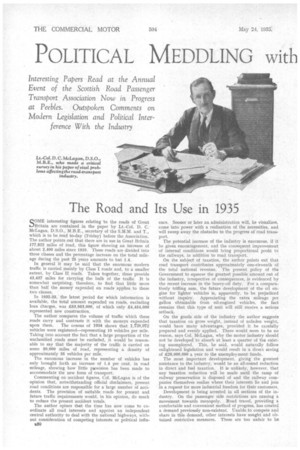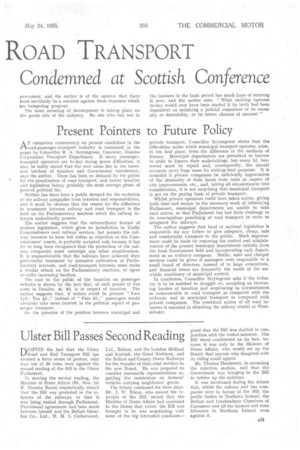POLITICAL MEDDLING with
Page 48

Page 49

If you've noticed an error in this article please click here to report it so we can fix it.
ROAD TRANSPORT
Condemned at Scottish Conference
Interesting Papers Read at the Annual Event of the Scottish Road Passenger Transport Association Now in Progress at Peebles. Outspoken Comments on Modern Legislation and Political Inter ference With the Industry
The Road and Its Use in 1935
SCOME interesting figures relating to the roads of Great Britain are contained in the paper by Lt.-Col. D. C. Mctagan, D.S.O., M.B.E. secretary of the S.M.M. and T., which is to be read to-day (Friday) before the Association. The author points out that there are in use in Great Britain 177,822 miles of road, this figure showing an increase of about 2,400 miles since 1910. These roads are divided into three classes and the percentage increase on the total mileage during the past 25 years amounts to but 1.4.
In general it may be said that the enormous modern traffic is carried mainly by Class I roads and, to a smaller extent, by Class II. roads. Taken together, these provide 43,437 miles for carrying the bulk of the traffic It is somewhat surprising, therefore, to find that little more than half the money expended on roads applies to these two classes.
In 1932-33, the. latest period for which information is available, the total amount expended on roads, excluding loan charges, was £53,953,000, of which only £4,454,000 represented new construction.
The author compares the volume of traffic which these roads carry and contrasts it with the moneys expended upon them. The census of 1934 shows that 1,738,972 vehicles were registered—representing 10 vehicles per mile. Taking into account the fact that a large proportion of the unclassified roads must be excluded, it would be reasonable to say that the majority of the traffic is carried on some 50,000 miles of road, representing a density of approximately 35 vehicles per mile.
The enormous increase in the number of vehicles has only brought foith an increase of 1.4 per cent. in road mileage, showing how little movision has been made to accommodate the new form of transport.
Commenting on accident figures, Col. McLagan is of the opinion that, notwithstanding official disclaimers, present road conditions are responsible for a large number of accidents. The provision of suitable roads for present and future traffic requirements would, in his opinion, do much to reduce the present accident totals.
The author opines that the time has now come to coordinate all road interests and appoint an independent central authority to deal with the national highways, without consideration of competing interests or political influ 380 ence. Sooner or later an administration will, he vistializes, come into power with a realization of the necessities, and will sweep away the obstacles to the progress of road transport. The potential increase of the industry is enormous, if it be given encouragement, and the consequent improvement of internal conditions would bring proportional profit to the railways, in addition to road transport.
On the subject of taxation, the author points out that road transport contributes approximately one-eleventh of the total national revenue. The present policy of the Government to squeeze the greatest possible amount out of the industry, irrespective of consequences, is evidenced by the recent increase in the heavy-oil duty. For a comparatively trifling sum, the future development of the oil engine for lighter vehicles is, apparently, to be prejudiced without inquiry. Appreciating the extra mileage per gallon obtainable from oil-engined vehicles, the fact remains that this type of unit will still receive a serious setback.
On the goods side of the industry the author suggests that taxation on gross weight, instead of unladen weight, would have many advantages, provided it be carefully prepared and evenly applied. There would seem to be no reason, says Col. McLagan, why the motor industry should not be developed to absorb at least a quarter of the existing unemployed. This, he said, would naturally follow enlightened legislation and would result in a direct saving of £28,000,000 a year to the unemployment funds.
The most important development, giving the greatest assistance to the industry, would be an all-round reduction in direct and fuel taxation. It is unlikely, however, that any taxation reduction will be made until the ramp of railway preservation is disposed of and the railway companies themselves realize where their interests lie and join in a request for more industrial freedom for their customers.
Development is being arrested in all sections of the industry. On the passenger side restrictions are causing a movement towards monopoly. Road travel, providing a comfortable and convenient method of progress, has created a demand previously non-existent. Unable to compete and share in this demand, other interests have sought and obtained restrictive measures. These ate too unfair to be permanent, and the author is of the opinion that there must inevitably be a reaction against these measures which are hampering progress.
The same arresting of development is taking place on the goods side of the industry. No one who was not in the business in the basic period has much hope of entering it now, and the author asks, "What existing bpsiness to-day would ever have been started if its birth had been dependent on satisfying a judicial committee of its necessity or desirability, or its future chances of success? "




































































































